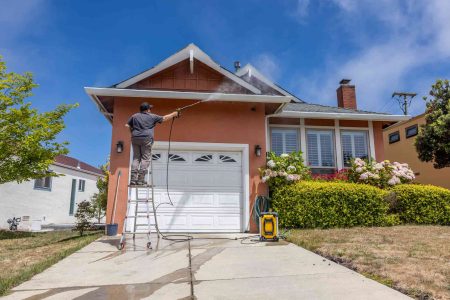A homeowner can fix some brick damage, but knowing the difference between a DIY-suitable repair and one that calls for a professional mason is essential. A DIYer should never attempt brick replacement on a load-bearing wall that needs replacing four or more contiguous bricks.
When a load-bearing wall is seriously damaged, it is a serious accident waiting to happen, and it’s best not to attempt your own repairs. For example, the exterior brick replacement work on chimneys is almost always load-bearing, and DIYers should tackle only minor repairs on such structures.
Masons are brick experts who charge about $20 to $40 per square foot or $40 to $75 per hour, depending on the damage and quality of the existing brick, according to HomeAdvisor. At a minimum, you can expect to pay about $200 to $400 for a few hours of work. However, the average brick repair job is about $1,600.
Fortunately, most brick homes have an outer brick facade constructed of a “veneered” brick wall. Veneered means it is a brick skin over wood framing. Since that brick wall is not load-bearing, you can confidently replace those bricks yourself. To replace an individual brick, remove it or if it doesn’t come out easily, carefully break it up to remove it; be mindful not to damage the surrounding bricks. Allow the replacement brick to soak in water before setting it.
Repairing Crumbling Brick
Bricks and mortar are porous. When you see crumbling brick, this is also called spalling or blowing. A blown brick or spalling is usually caused by water and time. Water expands and contracts when frozen, which can dislodge mortar and make bricks lose their rigidity. Erosion and weathering are harsh on bricks, particularly the mortar and air spaces that can hold water.
Another reason for crumbling brick is using high-pressure washers on a brick facade, which can be too forceful for bricks and masonry.
If you notice cracks in the brick or along the mortar lines in a staircase pattern, those breaks can indicate a bigger problem, such as shifts in the home’s foundation.
You can do minor repair projects on a solid load-bearing wall, but only if it needs four or fewer bricks replaced. Before replacing the bricks, consider using brick repair filler products instead. A filler is an excellent option for covering cracks, chips, drill holes, and other minor damage. Filler is usually ready-mixed, can be used for interior and exterior brick, and can match brick color and texture.
Before You Begin
Selecting the right replacement brick may sound easy but it’s essential to the aesthetic success of the repair. It’s not as simple as it sounds with an older home where the brickwork is many decades old. Even the standard red bricks can vary by color and size. If you have an old piece of the brick you’re replacing, take that with you to a brickyard to find an acceptable replacement. If the brick is very old, you can also try an architectural reclamation company where old reclaimed architectural materials are sold.
Study the existing brickwork before starting work so you’re prepared to mimic the look as closely as possible with your repair. Pay particular attention to the joints between bricks. You may need pigments and proper tools to create joints that are the proper color and shape.
Safety Considerations
One of the most common places for brickwork to fail is also the place where DIYers should be most reluctant to work—on rooftops where chimneys terminate, or high above the ground on exterior fireplace brickwork. Masonry work requires carrying heavy materials and working with both hands, and doing this kind of work high above the ground is best left to professionals who have the scaffolding and safety harnesses that allow them to do this work safely.
What You’ll Need
Equipment / Tools
- Eye protectors
- Leather work gloves
- Mason’s chisel
- Power drill or grinder with masonry-cutting wheel (optional)
- Mason’s hammer
- Wire brush
- Shop vacuum
- Plastic bucket with sponge
- Mortar mixing tray
- Pointing tool
- Jointer tool
Materials
- Matching replacement bricks
- Mortar mix
- Mortar pigment (if needed)
Instructions
How to Replace Damaged Bricks
-
Remove the Damaged Brick
While wearing eye protection and leather gloves, use a mason’s chisel and hammer to break apart the damaged brick piece by piece. If you are removing several bricks, then start at the top and work down. Be very careful not to damage surrounding bricks.
Once the brick pieces are removed, chisel out any old mortar, making the voids as clean as possible. Clean the joints of any loose mortar with a wire brush and vacuum the opening clean of any dirt or dust.
Rinse the cleaned area with water, including all four sides of the opening.
-
Mix Mortar
Mix the mortar according to the manufacturer’s directions. If the repair is such that matching the existing mortar color is important, you may have to experiment first with mortar pigment to obtain the proper color for the dried mortar.
-
Apply Mortar
Next, use a pointing trowel to “butter” the bottom and both sides of the existing opening with about 1 inch of mortar.
Immediately moisten the replacement brick with water, then “butter” it by applying mortar to the top and both sides of the brick.
-
Insert the Brick
Now, slide the brick into the opening. Mortar should ooze out slightly as the brick is being pushed into the wall. Tap into place with the butt end of a pointing trowel until it is flush with the existing bricks.
Once the brick is in place, make sure the joints are full to the face of the brick by adding more mortar with the pointing tool if necessary. Remove excess mortar by scraping it away with the side of the pointing trowel.
If your project involves replacing additional bricks, repeat the previous two steps to complete the repair.
-
Tool the Joints
Tool the mortar joints with the jointer tool so the fresh joint matches the joints found elsewhere on the wall. There are different types of jointer tools you can choose to give you joints of various widths and shapes. Some tools are designed to give you rounded, concave joints, for example, while others are designed to give you flat-bottomed joints.
Once the mortar is almost dry, use a wire brush and gently brush away leftover mortar from the face of the bricks, but take care not to disturb the tooled joints.
-
Cure the Repair
Spray the new repair lightly with water to aid in the proper curing of the mortar. Keeping the repair damp allows the mortar to cure and harden properly. Keep the area misted with water for three days. Cover the area with a plastic sheet, if desired, to help retain moisture.
When to Call a Professional
Brickwork is a difficult skill to master, and while DIYers can usually succeed in making minor repairs with acceptable results, it’s best to call in a professional mason whenever you’re faced with serious damage—such as when an entire wall shows ominous cracks, where when large sections of a brick facade are buckling. And brickwork done high above the ground—on a second-story fireplace wall or on a roof chimney, for example—should always be handled by a pro.
Brickwork that features an unusual layout pattern—or that uses unusual bricks—can also be hard for DIYers. Mistakes in brickwork repair will be visible for all the world to see for many years, so if you are uncertain of your skills, it is best to rely on professionals to do the work.
-
What causes brick to deteriorate?
Water enters the pores in bricks and the spaces in between bricks. When water freezes and melts repeatedly, this weathering action breaks apart the brick-and-mortar bonds, causing them to crumble.
-
How do you stop brick decay?
Several things can stop brick decay: repointing (also called tuckpointing) to replace crumbling mortar, coating the outside of the brick with a breathable sealant that allows moisture to evaporate, and reducing the use of high-pressure power washing on brick surfaces.
-
How long does it take for a brick to deteriorate?
Brick structures are built to last 100 years or more, according to the International Association of Certified Home Inspectors (IACHI). A study from Leeds Beckett University in the U.K. reviewed 860 homes and found that brick structures can have a lifespan of 500 years or more.
Read the full article here














